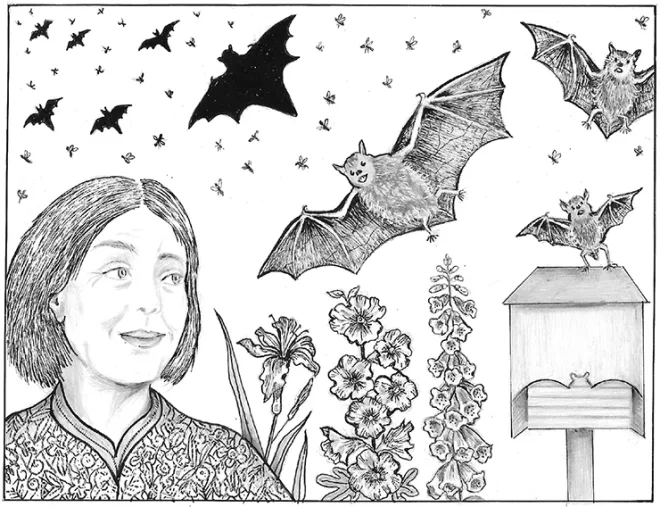This Fall I had a nasty surprise. I hadn’t suspected my roof was leaking, but it turned out to be so deteriorated that there was no choice: I had to get a new one before Winter. So on one of the last fine days of Autumn, I sat in the yard and watched as the old one was pulled off, filling a huge dumpster. The young roofers seemed fearless, dancing over the steep rafters as if they were flat. It was like watching a marvelous ballet, silhouetted as they were, carrying huge plywood boards, leaning, passing each other, seeming to move in time with the loud Spanish music that blared from the lawn.
I couldn’t tear myself away. It was as if I had journeyed to some exotic foreign country to see a famous acrobatic show. (Actually, I could have traveled a long way for what it cost!) Anyway, as they didn’t speak English, I showed them a picture of a bat and pointed to the attic of the house. They nodded vigorously.
I wasn’t surprised. Long ago on Summer nights, my husband and I used to count the bats as they came out of our roof to sweep over the darkening lawn or dip into the pond to drink. “Eat! Eat!“ Charles would cry. And they did.
Bats live in high, dark places, sleeping all day and emerging at night to hunt. Typically they would live in high church bell towers, or belfries. There is a saying that if a person has “bats in the belfry“ (head), he or she is a bit crazy—or, well, “batty.”

Bats look like flying mice, and, indeed, their German name is Fledermaus, but they are not even related to mice. Indeed, they are unique among mammals. Their Latin name is Chiroptera, meaning “hand wing.” Bird wings consist of an arm bone and a single “finger.“ But bat wings are constructed of four elongated fingers with a fifth hook used for climbing and hanging. Their wings are covered with two tough membranes with a space between for blood vessels, etc. There are nearly 1,000 species, including fruit-eating and blood-drinking (vampire) bats.
The little brown bats that lived in my attic (and that I hope returned!) consumed thousands of insects, mostly mosquitoes. As well as being invaluable for this, they are mesmerizing to watch as they swoop through the twilight skies (an old name for bats was vespertilio, from “vesper” or evening), navigating by each other with perfect accuracy. “Blind as a bat” is not accurate, for they can see, but they hunt mostly by echolocation, admitting very high-pitched squeaks that bounce off the prey they are chasing, however small.
In spite of their amazing qualities, bats’ reputation has never done them justice. Lewis Carroll compared them to a “tea tray in the sky” (which I don’t find funny). Most myths associate them with black magic, witches, and hell. Macbeth’s witches included “wool of bats” (as well as dogs’ tongues) in their disgusting brew. Paintings of the underworld almost always show some bats flying around.
We gardeners know better and will often buy a bat house for our yards. Even so, most people still fear them, thinking they can carry rabies or get entangled in their hair. I must say I, too, was scared when one ended up in my living room, especially as I had been reading Dr. Faustus when I felt it flutter near me! It left the house when I opened the doors and windows, but I needed to call my son in California for moral support (he walked me through the experience on my cell phone). Anyway, bats can get rabies but it isn’t common, and they don’t get tangled in anything, even human hair.
A 12th-century bestiary described them as “paltry animals,” but touchingly added that “they hang on to each other…like a cluster of grapes. And this they do from a certain duty of affection of a kind which is difficult to find in men.” (Sadly, we don’t always feel to each other a “duty of affection.“) Lately bats have become entangled in the world pandemic, said to have originated from bats in the roof of a Chinese market. Whether or not this is true, it certainly isn’t their fault!
Bats don’t have many enemies, apart from humans, though they are sometimes hunted by owls. In Shakespeare’s “The Tempest,“ Ariel crouches in a cowslip “when owls do cry,“ but then “on a bat’s back I do fly“ to hide in the blossoms “under the bough.“ The bat presumably then returned to its dark home.
Bats live a long time, up to 20 years. Maybe the bats that came out from my roof are the same ones Charles used to watch on Summer evenings. I hope so. They have one “pup“ a year (any more would be too heavy to carry in flight), and once born, the pup nurses on the sides of his mother’s belly to which it clings.
My new roof has a 50-year warranty, and there should not be any new holes in it. Still I hope the bats found a way back in, and that they will still be around when the roof (and I) give out. For bats surely come from heaven, not hell.
If you ask me. ❖




I think bats are one of the coolest animals ever and have placed two bat houses in my yard. I did lots of reading about them. It’s been two years and no bats have move in yet. But from my reading it can take awhile for them to move in. I have seen them in at night around my house, fingers crossed they’ll take a liking and move in.